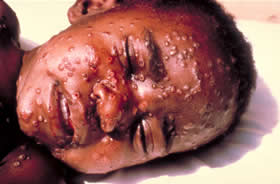Smallpox Vaccine from Cowpox blisters - Edward Jenner
Edward B. Jenner (18th May 1749 – 26 January 1823) was an English scientist who is credited as the first doctor to introduce and study the smallpox vaccine.
Around this time smallpox was greatly feared, as one in three of those who contracted the disease died, and those who survived were often badly disfigured. Voltaire, recorded that 60% of people caught smallpox, with 20% of the population dying of it. Smallpox is an infectious disease unique to humans. Smallpox localizes in small blood vessels of the skin and in the mouth and throat. In the skin, this results in a characteristic maculopapular rash, and later, raised fluid-filled blisters.
Noting the common observation that milkmaids did not generally get smallpox, Jenner theorized that the pus in the blisters which milkmaids received from cowpox protected the milkmaids from smallpox. He may have had the advantage of hearing stories of Benjamin Jesty and others who deliberately arranged cowpox infection of their families, and then noticed a reduced smallpox risk in those families. Cowpox is a disease of the skin that is caused by a virus known as the Cowpox virus and got its name from dairymaids touching the udders of infected cows. The ailment manifests itself in the form of red blisters and is transmitted by touch from infected animals to humans.
On 14 May 1796, Jenner tested his theory by inoculating James Phipps, a young boy of 8 years old, with material from the cowpox blisters of the hand of Sarah Nelmes, a milkmaid who had caught cowpox from a cow called Blossom. Phipps was the 17th case described in Jenner's first paper on vaccination.
Jenner inoculated Phipps with cowpox pus in both arms on the same day. The inoculation was accomplished by scraping the pus from Nelmes' blisters onto a piece of wood then transferring this to Phipps' arms. This produced a fever and some uneasiness but no great illness. Later, he injected Phipps with variolous material, which would have been the routine attempt to produce immunity at that time. No disease followed. Jenner reported that later the boy was again challenged with variolacious material and again showed no sign of infection.
He continued his research and reported it to the Royal Society, who did not publish the initial report. After improvement and further work, he published a report of twenty-three cases. Some of his conclusions were correct, and some erroneous—modern microbiological and microscopic methods would make this easier to repeat. The medical establishment, as cautious then as now, considered his findings for some time before accepting them. Eventually vaccination was accepted, and in 1840 the British government banned variolation- the use of the smallpox itself- and provided vaccination- using cowpox- free of charge. Jenner's continuing work on vaccination prevented his continuing his ordinary medical practice. He was supported by his colleagues and the King in petitioning Parliament and was granted £10,000 for his work on vaccination. In 1806 he was granted another £20,000 for his continuing work. In 1803 in London he became involved with the Jennerian Institution, a society concerned with promoting vaccination to eradicate smallpox. In 1808, with government aid, this society became the National Vaccine Establishment.
Smallpox is believed to have emerged in human populations about 10,000 BC. Blindness resulting from corneal ulceration and scarring, and limb deformities due to arthritis and osteomyelitis are less common complications, seen in about 2–5% of cases. The disease killed an estimated 400,000 Europeans each year during the 18th century (including five reigning monarchs), and was responsible for a third of all blindness. Of all those infected, 20–60%—and over 80% of infected children—died from the disease.
During the 20th century, it is estimated that smallpox was responsible for 300–500 million deaths. In the early 1950s an estimated 50 million cases of smallpox occurred in the world each year. As recently as 1967, the World Health Organization estimated that 15 million people contracted the disease and that two million died in that year. After successful vaccination campaigns throughout the 19th and 20th centuries, the WHO certified the eradication of smallpox in December 1979. To this day, smallpox is the only human infectious disease to have been completely eradicated.

A child infected with smallpox
|